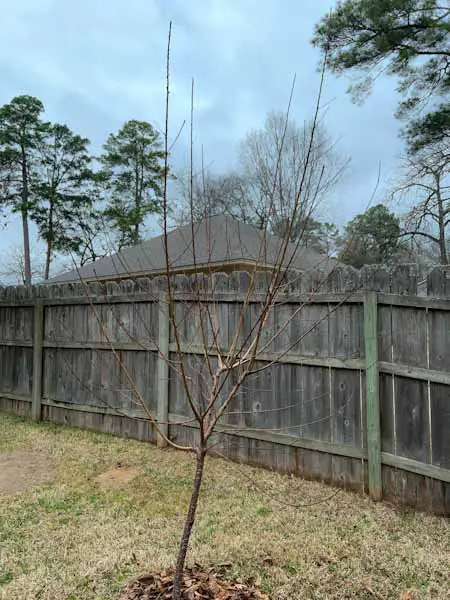
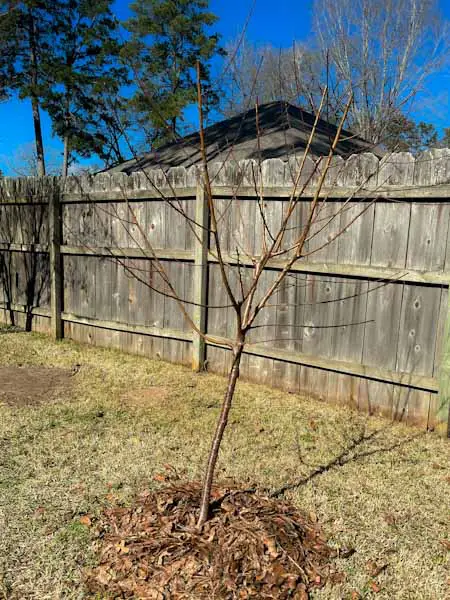
We may receive commissions from purchases made through links in this post, at no additional cost to you.
Pruning can be an intimidating-but-necessary job for peach tree owners, but it doesn’t have to be complicated. Commercial peach orchards employ pruning experts so they can maximize the fruit production of every tree on every acre of land. But anyone can learn the basics of pruning and see great improvements in their backyard peach harvest.
Thankfully, there’s more than one “right” way to prune a peach tree (and if all else fails, you can always just plant a dwarf tree!). Our goal is to provide clear and concise information so that you can confidently tackle the job. This article explains the basic principles of pruning, why it’s important for peaches, and gives simple steps to guide you through the process of pruning peach trees.
Table of Contents
- Why Do Peach Trees Need Pruning?
- When to Prune a Peach Tree
- Tips for Proper Pruning
- Pruning Tools
- How to Prune a Peach Tree
Why Do Peach Trees Need Pruning?
Simply put, peach trees need yearly pruning to help them live longer and fruit better. Moderate pruning every year (as opposed to heavy pruning every now and then) is the best bet for overall vigor and fruit production, and it is a critical part of peach and nectarine tree care. Here’s what pruning does:
- Provides a good structural framework to support the fruit
- Increases fruit quality and size
- Maximizes exposure to light, which is essential for fruit ripening and flavor
- Helps balance root growth with top growth
- Manages tree size, making harvest easier
- Reduces the tree’s susceptibility to disease and pest problems
- Lengthens the tree’s life and benefits the overall health of the tree
To read even more about why pruning peach trees is essential, see 10 Reasons You NEED to Prune Your Peach Tree.
What happens if I don’t prune my peach trees?
But what if you skip this step? Over the long run, forgetting to prune causes some pretty big issues for peach trees and their fruit. Letting the tree grow unchecked will weaken it and cause its life to shorten. A weaker tree is more susceptible to cold damage, water stress, and disease and pest pressures.
An unpruned tree may produce too many peaches that stay small and underdeveloped. If the tree’s energy is focused on supporting a large canopy and branch growth, then it won’t have enough left to ripen the fruit.
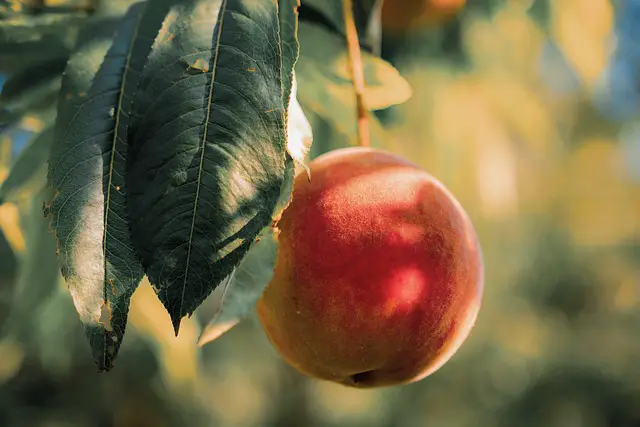
As the tree grows, the volume of fruit-producing branches decreases and grows higher on the tree (eventually out of reach). If a peach tree isn’t pruned annually, it will produce fewer and fewer peaches as it ages. Heavy pruning every few years will cause the tree to grow too vigorously the following year, reducing the peach crop.
There are only upsides to pruning peach trees. It may seem like a lot of work every year, but once the tree is established, the job can be done quickly and simply. The first step is to know when to prune, and the benefits of pruning at different times of the year.
When to Prune a Peach Tree
The primary time to shape and prune peach trees is while they are dormant, but some summer pruning has benefits as well. There are different objectives when pruning at different times of year.
Watch the video below to see exactly how I prune my peach trees in the late winter/early spring:
Late Winter Pruning
The bulk of pruning will happen at the end of winter while the peach tree is still in its dormant phase. The objectives are:
- Establishing the overall shape of the tree – The best peach tree shape for maximum harvest is an “open center” structure (picture the shape of a vase – narrow at the bottom and wider at the top). This simply means removing the central “leader” branch and keeping 3-5 outward-spreading branches (known as “scaffolds”) as the main structure. This allows for maximum light exposure and airflow, increasing the health and strength of the tree.
- Limiting tree size – If left to grow unchecked, a peach tree can grow to be 25 feet tall (or more!). It would be pretty hard to harvest fruit at that height, especially because as the tree ages the fruiting wood grows higher. Most commercial orchards keep their trees between 7 and 10 feet tall for easy fruit access. This is easily accomplished with dormant pruning.
- Removing excess fruiting shoots – It may seem counterintuitive to remove fruiting wood, but peach trees often produce more than they can support. Too many shoots will shade the tree, keeping fruit from ripening properly. Excessive fruit will also tax the tree’s limited resources, meaning the fruit will remain small and underdeveloped.
- Removing upright “water sprouts” and “suckers” – Water sprouts are the vigorous shoots that grow straight up from the trunk and branches. They won’t produce fruit, and if left in place they will leach nutrients and energy away, weakening the rest of the tree. Suckers are similar, but they originate from the tree’s root system, so they are found near the base of the tree or even growing straight up out of the ground. Regular, moderate pruning will help control sucker growth, but they should be removed as soon as they show up.
- Removing diseased, damaged, or crossing branches – Anything that diverts the tree’s resources from healthy growth and fruit production should be pruned away. Diseased and damaged branches need to be removed so they don’t stress the tree and lead to further health issues. Crossing branches (or branches that are growing too close together) cause excessive shading and limit airflow.
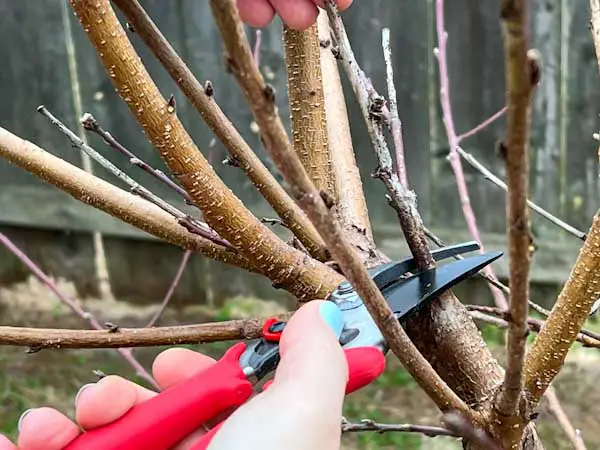
Be careful not to dormant prune too early in the winter. Pruning will signal the tree to start growing as soon as the weather warms up, so a late spring frost could be devastating to any new growth. Wait to prune as late as possible before spring growth starts (usually in February for warmer climates, March for colder climates).
If you prune in early winter soon after the tree loses its leaves, it will be more susceptible to cold damage and disease (such as bacterial canker). Early winter pruning actually reduces cold hardiness, so leave on all old fruiting wood until after the last freeze.
Summer Pruning
A little bit of pruning in the summer (emphasis on little) can help maximize fruiting and provide optimum growth. Remove suckers and water sprouts as soon as they appear. Prune away any shoots that are shading the tree’s interior and interfering with the vaselike shape. You want as much light and energy as possible to get to the growing peaches.
There’s no benefit to leaving damaged or diseased limbs on a peach tree. In fact, dead or damaged branches can encourage diseases and pests to take a stronger hold, weakening the tree. Remove these with a flush cut as soon as you notice them.
It is recommended to thin young peaches when they are about a 1/2 to 1 inch in diameter. Simply pinch off any diseased, damaged, or too-small fruits, and leave the rest of the peaches about 6 to 8 inches apart. This will allow the tree to provide enough nutrition to the remaining fruit, helping the peaches grow bigger and more delicious. (Read Should I Thin the Fruit on My Peach Tree? for more information).
One caveat – for those in hotter climates, keep summer pruning to a minimum. Extreme heat and humidity put the tree under stress, so excessive pruning in hot weather could hurt more than it helps. (For more hot-weather peach tips, read Growing Peach Trees in Hot Climates: What Do I Need to Know?).
Tips for Proper Pruning
The kind of growth you are removing will determine what kind of cut should be made and where exactly it’s positioned. Here’s what you need to know:
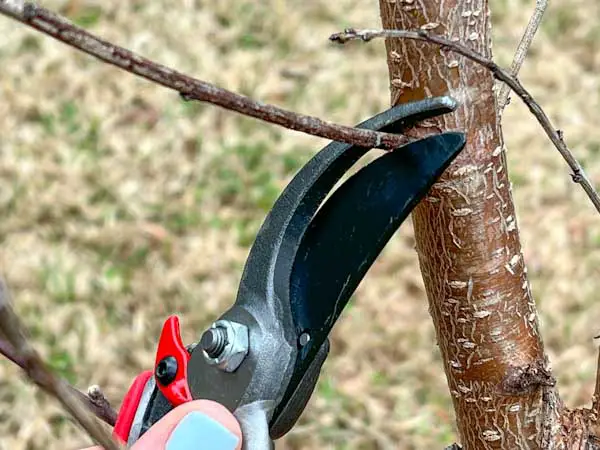
Thinning Cuts
These are cuts made to remove unwanted shoots and open the canopy to increase airflow and light. If you remove a branch right at its point of origin, it won’t signal the tree to grow another branch.
Heading Cuts
These cuts influence the growth of the tree. Use a heading cut to remove terminal buds on the ends of branches and encourage new shoots to grow. This kind of cut strengthens branches and helps control the size of the tree.
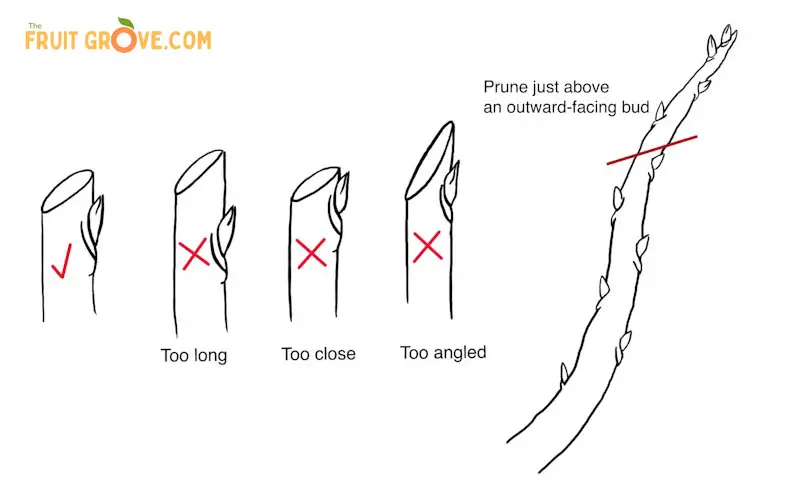
Cut Angle
When you are pruning a branch to a bud, make the cut cleanly at about a 45-degree angle. If you cut too close to a bud, then the bud will die back. Cutting too far above the bud will make the stub slow to heal over and could invite disease.
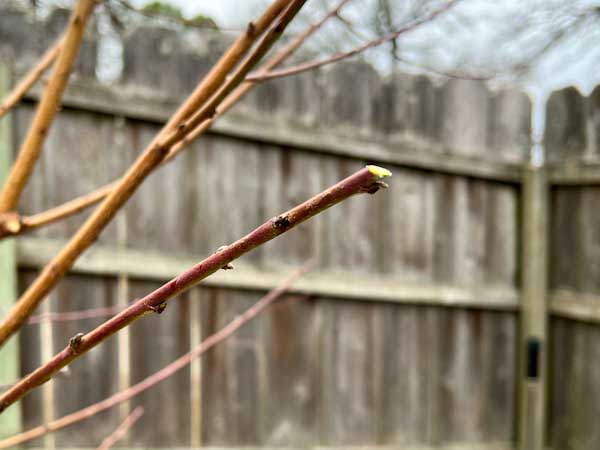
Avoid “crotch” angles (the V-shaped angle between two branches) that are too narrow, as these can cause splitting and breakage once the branches are loaded down with peaches. Keep branches that have wider crotch angles, closer to 10 o’clock and 2 o’clock.
Cut Position
When pruning to influence the shape of the tree, cut just above a bud that is facing outward (usually on the underside of a branch). Remember, the goal is to keep the center of the tree open, so encouraging outward growth is the way to go. Make a clean, angled cut about 1/4 inch above the bud.
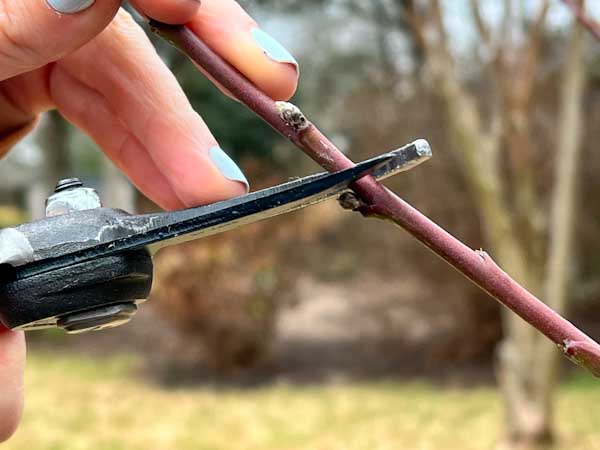
Pruning Tools
Here’s all you need to prune your peach trees (plus some bonus helpful items):
- Hand pruners/secateurs – choose pruners that can be easily sharpened or that have replaceable blades. Use these to thin fruit and remove small- to moderate-sized branches.
- Loppers – Use these to thin leafy growth or get to harder-to-reach twigs.
- Eye protection – Don’t skip this…pruning is a messy job, so protect those eyes.
- Gloves – Protect your skin from irritation, scratches, and accidental cuts.
- Long sleeves – Not a tool, exactly, but essential to prevent scratches and irritation.
- Bonus: Hand saw – If you plan to cut any branches thicker than an inch or two, then you need a hand saw. Use this when establishing the overall tree shape, or when you need to remove a larger branch.
- Bonus: Telescopic pruner – Hopefully the tree has been pruned to stay more compact, but telescoping pruners (which are basically pruners at the end of a long pole) will make reaching tall branches easier.
- Bonus: Stepladder – You may need some help reaching the higher branches, especially if you don’t have a pole pruner.
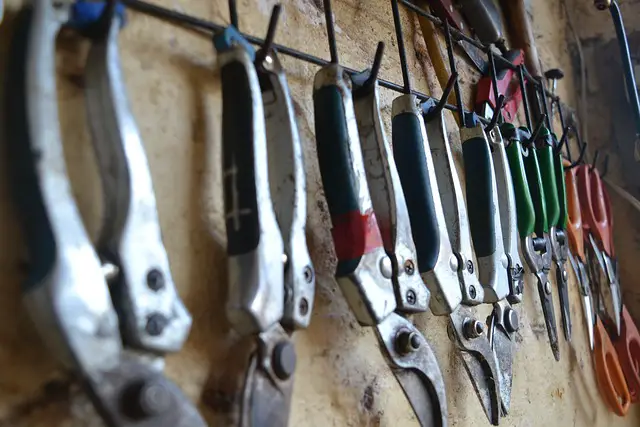
Be sure to disinfect your tools before beginning pruning. Bacteria and fungal diseases can linger on uncleaned tools. The fresh cuts made when pruning can be very susceptible to infection, and dirty tools are the main culprit. Disinfect tools by soaking them in a solution of 2 cups of bleach to 1 gallon of water, or by wiping them down with an alcohol-soaked cloth.
Also, keep your pruning tools as sharp as possible. A dull cut will wound the tree, prevent it from healing well, and make it more vulnerable to diseases, pests, and cold damage. Clean, sharp cuts heal quickly.
It’s worth investing in high-quality gardening tools that will last forever. To help your tools be useable for as long as possible, clean and dry them after each use. Store them in a protected area away from extreme temperatures, to avoid the handles cracking. You can even rub the metal with plant-based oil, such as boiled linseed oil, to protect the blades from rusting (avoid using any petroleum-based oils, as this will leach into the soil).
How to Prune a Peach Tree
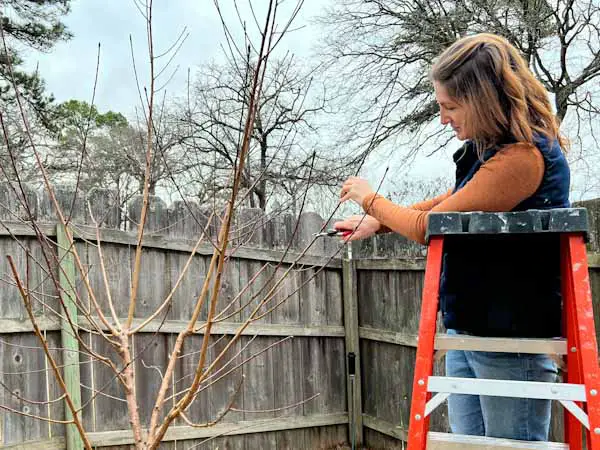
The First Year
The first winter after planting (while the tree is dormant), prune to establish its shape. Many trees come straight from the nursery already pruned into an open center structure. If yours didn’t, then follow these steps:
- Cut the central leader (the main trunk/branch growing straight up) about 30 inches above the soil line (a little above the highest scaffold branch – see step 2).
- Choose 3 to 5 strong branches, or scaffolds, and remove all others. The scaffolds should be spread evenly around the trunk, with about 6 inches of height between each branch (keep the lowest branch at least 18 inches from the ground). Only keep scaffold branches that are at a 45-degree or wider angle to the trunk.
- Prune each scaffold branch to about 1/3 of its overall length.
The Second Year
The goal this year is to refine the shape of the tree and promote fruit-bearing wood. While the tree is dormant:
- Remove any lateral branches other than the scaffolds, cutting just about flush to the trunk.
- Prune fast-growing shoots (water sprouts and suckers), but leave twig growth alone (this is usually the fruit-bearing wood).
- Make a heading cut at the end of each scaffold to remove about 1/4 of the branch. Make the cut just above an outward-facing bud.
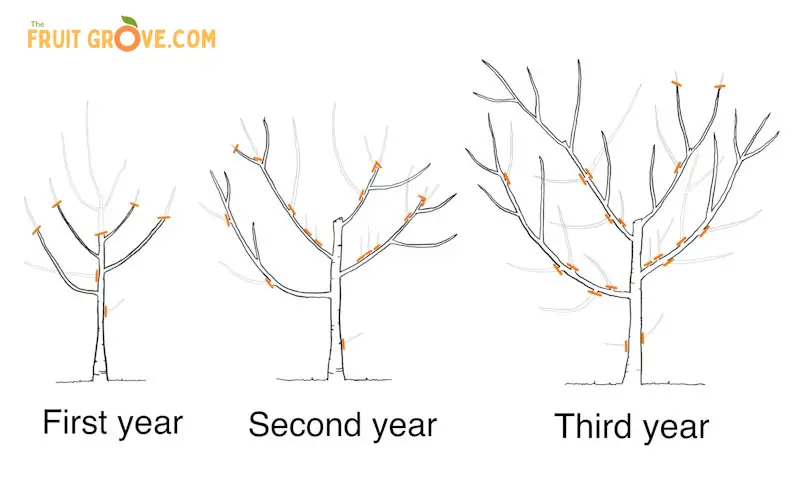
The Third Year
The tree’s structure should be fairly established by now, so hopefully there isn’t too much that needs to be adjusted this year (again, prune at the end of winter).
- Remove broken, diseased, damaged, or dead branches.
- Remove suckers and water sprouts.
- Remove branches growing inward that interfere with the open center of the plant (these can cause shading and inhibit air flow).
- (If necessary, make heading cuts to the branches to encourage a better shape.)
- Avoid any excessive pruning until the tree has produced a decent-sized crop.
Pruning a Mature Peach Tree (3 Years or Older)
Once you did the work to shape the peach tree, annual pruning should be a breeze. The main goals are to maintain the size and shape of the tree, encourage fruiting wood, and remove any problematic branches that can zap nutrients and energy from the rest of the tree.
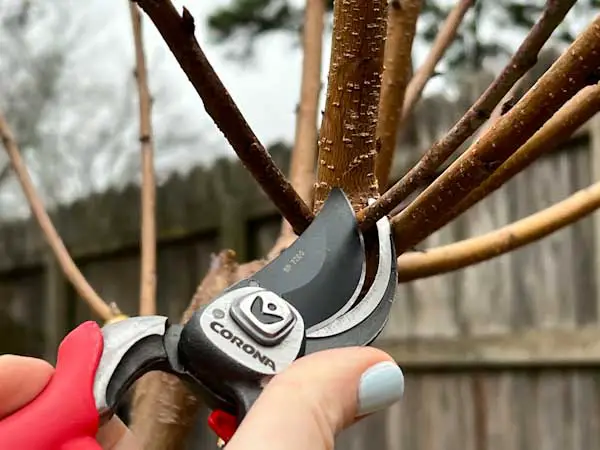
- Remove suckers and water sprouts.
- Remove inward-growing shoots.
- Remove dead, diseased, or damaged wood.
- Prioritize keeping the 18-24 inch fruiting shoots (typically last year’s growth). Cut each of last year’s branches back by about half.
- If necessary, remove growth at the top of the tree, above about 7 feet.
- Overall, aim to prune about a third of the tree each winter, as this will manage fruit production and increase the tree’s health and vigor.
And that’s it! Don’t be intimidated – pruning for the home gardener does not have to be a complicated process. In a nutshell – remove dead growth, those pesky suckers, and keep the tree a manageable size. Thin the fruit when it is small, and then sit back and watch the peaches develop and your tree thrive.

